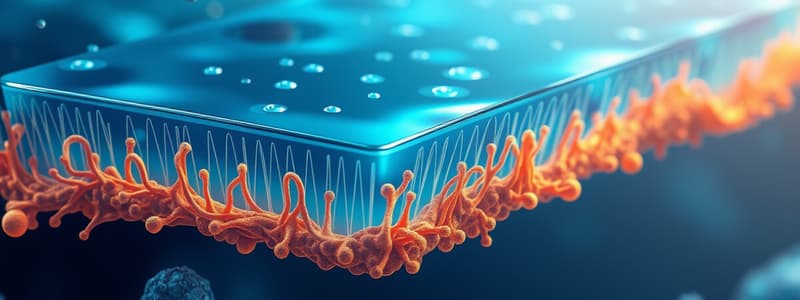Podcast
Questions and Answers
What are the three main components of the lipid bilayer portion of a plasma membrane?
What are the three main components of the lipid bilayer portion of a plasma membrane?
- Cholesterol, proteins, and glycoproteins
- Phospholipids, proteins, and carbohydrates
- Phospholipids, triglycerides, and sterols
- Phospholipids, cholesterol, and glycolipids (correct)
What type of membrane protein extends across the entire lipid bilayer touching both intracellular fluid and extracellular fluid?
What type of membrane protein extends across the entire lipid bilayer touching both intracellular fluid and extracellular fluid?
Transmembrane protein
Which type of membrane proteins function by recognizing and binding to hormones and neurotransmitters?
Which type of membrane proteins function by recognizing and binding to hormones and neurotransmitters?
Receptors
What is the measure of a solution's ability to change the volume of cells by altering their water content?
What is the measure of a solution's ability to change the volume of cells by altering their water content?
What transport process uses energy from the hydrolysis of ATP to drive substances across the membrane against their own concentration gradients?
What transport process uses energy from the hydrolysis of ATP to drive substances across the membrane against their own concentration gradients?
Which transport process uses vesicles that fuse with the plasma membrane to secrete materials into the extracellular fluid?
Which transport process uses vesicles that fuse with the plasma membrane to secrete materials into the extracellular fluid?
During phagocytosis, binding of a particle to a plasma membrane receptor triggers the formation of _____, which are extensions of the plasma membrane of the phagocyte.
During phagocytosis, binding of a particle to a plasma membrane receptor triggers the formation of _____, which are extensions of the plasma membrane of the phagocyte.
Microfilaments, intermediate filaments, and microtubules are all components of a cell's?
Microfilaments, intermediate filaments, and microtubules are all components of a cell's?
Which membrane-enclosed organelle is the site of synthesis of membrane proteins and secretory proteins?
Which membrane-enclosed organelle is the site of synthesis of membrane proteins and secretory proteins?
Which membrane-enclosed organelle can engulf a worn-out organelle, digest its chemical components, and recycle those digested components?
Which membrane-enclosed organelle can engulf a worn-out organelle, digest its chemical components, and recycle those digested components?
Describe five different functions of integral membrane proteins.
Describe five different functions of integral membrane proteins.
Briefly state the functions of the rough and smooth endoplasmic reticulum.
Briefly state the functions of the rough and smooth endoplasmic reticulum.
Flashcards are hidden until you start studying
Study Notes
Lipid Bilayer Components
- Composed of phospholipids, cholesterol, and glycolipids.
Types of Membrane Proteins
- Transmembrane proteins extend across the lipid bilayer, interacting with both intracellular and extracellular fluids.
- Receptor proteins recognize and bind to hormones and neurotransmitters.
Tonicity
- Refers to a solution's ability to change cell volume by altering water content.
Transport Processes
- Primary active transport utilizes ATP hydrolysis to move substances against their concentration gradients.
- Exocytosis involves vesicles fusing with the plasma membrane to secrete materials into the extracellular fluid.
Phagocytosis
- When particles bind to plasma membrane receptors, pseudopods form to engulf the particle, leading to phagosome creation.
Cytoskeleton Components
- Comprised of microfilaments, intermediate filaments, and microtubules.
Rough Endoplasmic Reticulum (RER)
- Responsible for synthesizing membrane and secretory proteins.
Lysosomes
- Membrane-enclosed organelles that digest and recycle worn-out organelles.
Functions of Integral Membrane Proteins
- Signal transduction: reaction initiation when a molecule binds to a receptor.
- Transport: facilitates movement of molecules and ions across the membrane.
- Enzymatic activity: enzymes convert substrates to products.
- Intracellular binding: attachment for adhesion through binding proteins.
- Cell recognition: helps identify cells for proper function.
Smooth Endoplasmic Reticulum (SER)
- Synthesizes fatty acids and steroids, differing from the RER's role in glycoprotein and phospholipid synthesis.
Studying That Suits You
Use AI to generate personalized quizzes and flashcards to suit your learning preferences.




